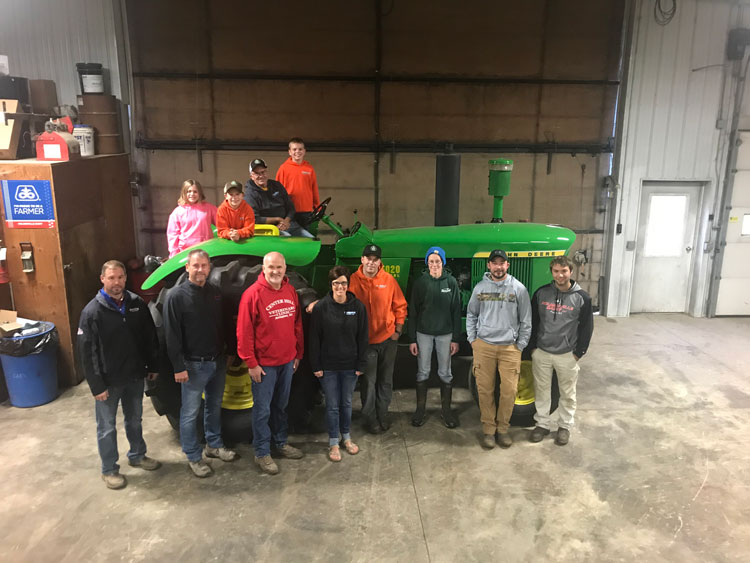
We have made several improvements over the past few years to help our cows and heifers that are safe in calf,” said Travis Holmes, the lone repeat winner in the 13th Annual Dairy Cattle Reproduction Council’s award competition. “We now have headlocks in all of our freestall pens, prefresh and postfresh barns, and for all of our heifers starting at 12 weeks of age,” Holmes went on to say.
“For heat abatement, we have added misters in the freestall barns along with lots of fans to keep the cows cool,” continued the Argyle, Wis., dairyman. “For our bovines that need to eat outside at headlocks, we added a shade cloth over the bunks. We have also added in fans for our dry cows and prefresh cows.
“Last summer, we removed the last of our mattresses, made our freestalls bigger and more accommodating, and went to 100% sand bedding,” Holmes said of the continued improvements to facilities that led to their herd’s industry-leading reproduction.
All six of this year’s Platinum winners of the Dairy Cattle Reproduction Council’s awards share additional insight in this Hoard’s Dairyman Intel as well as the Round Table found on pages 675 to 678 of the November issue of Hoard’s Dairyman. This year’s competition drew the second-largest set of nominations to date — 107.
Here are additional responses to the question, “Have you updated your facilities?”
Davis Family Dairies, Nicollet, Minn.: We have changed from evaporative cooling cells to feed line soakers in our cross-ventilated barns. We believe this has dramatically reduced variation in dry matter intake and improved heat expression during the summer months. We believe this has helped both milk production and reproductive efficiency during the summer.
Hendriks Dairies, Brucefield, Ontario: We are in relatively new facilities and had the main goal of cow comfort when designing. We have a three-row, sand-bedded, tunnel-ventilated barn and use long-day lighting over the milk cows.
Changes we are considering for the future are a larger fresh cow group housed in sand stalls for three weeks and having far-off dry cows in sand stalls to allow further changes to our selective dry cow therapy parameters.
High Noon Dairy, Hereford, Texas: We wanted to eliminate overcrowding in fresh cow pens. To accomplish this goal, we expanded our fresh cow pens to accommodate a longer stay for fresh heifers for up to 21 days in milk (DIM) or even longer. We also changed dairy operation hours to counter the extreme heat in the summer months. We split feeding shifts to move cows out from the shade in the late evenings when the heat is extreme.
Patterson Farms, Auburn, N.Y.: In 2014, we installed chimneys in the holding area to help alleviate heat stress. We did see a reduction in early embryonic death after making this change. In 2018, we switched from using the AFI system to utilizing the SCR system in the heifer barn for heat detection. We did see a bump in performance. But, more importantly, the change was an additional safety benefit for our employees by using ear tags versus leg bands.
We like to minimize the effects of heat stress and don’t want to see our animals’ health and performance compromised during the summer months. To minimize the impact, we have misters along each lactating group’s feedbunk, a sprinkler system in the holding area for the cows waiting to be milked, sand stalls for the cows in second lactation or greater, and fans everywhere to maximize airflow and water evaporation. In 2018, we also put up a new dry cow facility featuring sand-bedded freestalls and an ample number of fans to keep those important animals as comfortable as possible.
Riverside Dairy, Reedsville, Wis.: All of the lactating, dry cow, and holding areas have circulating fans; high-volume, low-speed ceiling fans; and misters. All overhead doors are closed and curtains are partially lowered to create a dark, shaded environment free from direct sunlight and direct radiant heat. Lights are timed to turn off during the day at the peak heat days of summer.
Flies are sprayed monthly to help reduce bunching. Floors are grooved and have been diamond cut diagonally. Feed is delivered by 4 a.m., so cows consume their biggest meals when it is cool. The use of sand bedding provides a cool, comfortable place to lie and adds traction to alleys and cross-overs.
We have a professional hoof trimmer do maintenance trims monthly, and we have a chute that I (Andy) can address lame cows in the interim. We see more lameness in the summer months due to standing and perching on backs of stalls. I credit my employees who separate these cows off from the parlor so I can quickly get them back to walking better.
This Hoard’s Dairyman Intel article is part of a three-part series detailing top reproduction tips from the Platinum winning herds for the 13th annual Dairy Cattle Reproduction Council (DCRC) awards competition.
Click below to view previous reports from this DCRC series:
Fresh cow problems begin in the dry period








